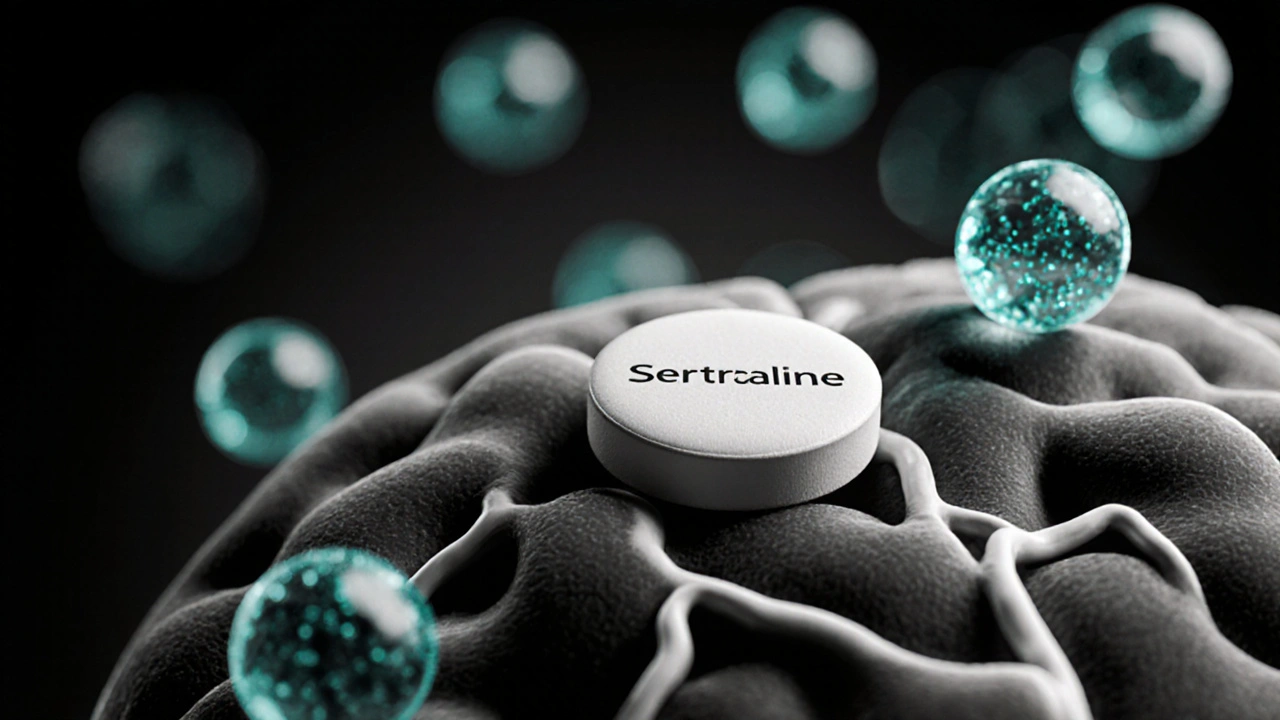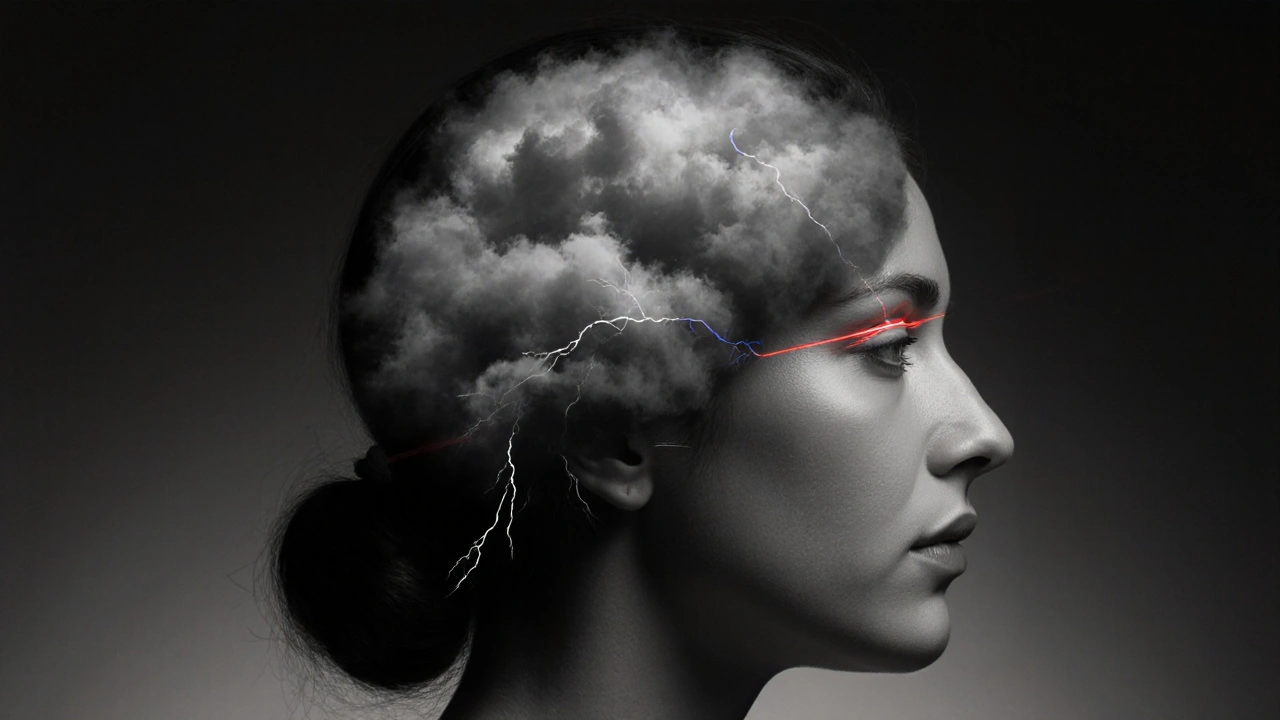Sertraline Migraine Risk/Benefit Calculator
This tool estimates potential migraine reduction from Sertraline based on clinical studies, while highlighting important risks. Results are for informational purposes only and should not replace professional medical advice.
Estimated Results
Key Benefit: For patients with depression or anxiety, Sertraline may improve both mood and migraine frequency. Studies show a 20-30% reduction in migraine days per month when used long-term.
Key Risk: Potential side effects include nausea, insomnia, and sexual dysfunction. The risk increases when combining with other serotonergic drugs. Serious risks include serotonin syndrome with certain medications.
Recommended Next Steps
- Discuss these results with your neurologist or headache specialist
- Consider a 8-12 week trial to assess effectiveness
- Monitor for side effects using a headache diary
When a migraine hits, the pain can feel like a thunderstorm inside your head. Many people wonder if the antidepressant Sertraline and migraines could be a hidden rescue tool. Below we unpack what the drug does, how it might intersect with migraine biology, and whether you should consider it as a preventive option.
Key Takeaways
- Sertraline is an SSRI primarily prescribed for depression and anxiety, not a first‑line migraine drug.
- Some small studies suggest it may lower migraine frequency, likely by stabilising serotonin levels.
- Evidence is mixed; benefits are modest and not guaranteed for every patient.
- Typical preventive doses range from 50‑100mg daily, but a doctor must tailor the regimen.
- Potential side effects include nausea, insomnia, and sexual changes, so weigh risks against possible relief.
What Is Sertraline?
Sertraline is a selective serotonin reuptake inhibitor (SSRI) used to treat depression, anxiety disorders, obsessive‑compulsive disorder, and post‑traumatic stress disorder. It works by blocking the reabsorption of serotonin in the brain, keeping more of the neurotransmitter available to improve mood and anxiety symptoms. The drug is sold under brand names like Zoloft and Lustral, and it’s been on the market since the early 1990s.
How Migraines and Serotonin Connect
To see why sertraline might affect headaches, you need a quick crash‑course on migraine biology. A migraine attack begins with a wave of neuronal excitement that triggers the release of vasoactive substances, notably calcitonin‑gene‑related peptide (CGRP) and serotonin. When serotonin levels spike, blood vessels constrict; when they drop, vessels dilate, contributing to the throbbing pain.
Serotonin is a neurotransmitter that regulates mood, sleep, and vascular tone. Because sertraline raises extracellular serotonin, it can theoretically dampen the vascular changes that spark a migraine.
However, the relationship is a two‑way street. Too much serotonin can also trigger headaches, which is why some migraine drugs (like triptans) act as serotonin5‑HT₁B/1D receptor agonists, deliberately causing brief vessel constriction to abort an attack. The net effect of SSRIs on migraine frequency is therefore not straightforward.

What Does the Research Say?
Clinical data on sertraline as a migraine preventive are limited but worth reviewing.
- Small open‑label trials (10‑30 participants) have reported a 20‑30% reduction in monthly migraine days after 12weeks on 50‑100mg sertraline.
- A 2015 crossover study compared sertraline to placebo in 45 patients with chronic migraine and comorbid depression. Sertraline lowered attack frequency by an average of 1.2 days per month, but the difference didn’t reach statistical significance after correcting for multiple comparisons.
- Systematic reviews on SSRIs for migraine prevention (published 2022) conclude that evidence is “low quality” and that any benefit is modest at best.
The common thread is that sertraline appears to help most when the patient also suffers from depression or anxiety-conditions that themselves can amplify migraine severity. When mood improves, the brain’s pain‑processing pathways often calm down, indirectly reducing headaches.
How Doctors May Use Sertraline for Migraine Prevention
Because sertraline isn’t FDA‑approved for migraine prophylaxis, a physician will typically prescribe it off‑label only after other preventive options have failed or when a mood disorder co‑exists.
- Starting dose: 25mg once daily, usually taken in the morning to minimise insomnia.
- Titration: Increase by 25mg every 1‑2weeks, aiming for 50‑100mg daily based on tolerance and response.
- Monitoring: Track migraine frequency, severity, and any side effects in a headache diary for at least 8‑12weeks before judging effectiveness.
If migraines don’t improve after 3months at a stable dose, a doctor will likely switch to a medication with stronger evidence, such as a beta‑blocker or a CGRP antagonist.
How Sertraline Stacks Up Against Other Preventive Medications
| Medication | Typical Dose for Prevention | Evidence Strength | Primary Use | Common Side Effects |
|---|---|---|---|---|
| Sertraline | 50‑100mg daily | Low‑quality/off‑label | Depression, anxiety, occasional migraine prophylaxis | Nausea, insomnia, sexual dysfunction |
| Propranolol | 40‑240mg divided | High (LevelA) | Hypertension, migraine prevention | Fatigue, cold extremities, bradycardia |
| Amitriptyline | 10‑50mg nightly | Moderate (LevelB) | Depression, chronic migraine | Weight gain, dry mouth, drowsiness |
| Erenumab (CGRP antagonist) | 70mg subcutaneous monthly | High (LevelA) | Chronic migraine prevention | Constipation, injection site pain |
Notice that sertraline’s evidence rank sits at the bottom of the table, while beta‑blockers and CGRP blockers sit near the top. The choice often comes down to personal health profile and whether a mood disorder needs simultaneous treatment.

Safety, Side Effects, and Drug Interactions
All medicines carry risk, and sertraline is no exception.
- Common side effects: Nausea, headache, dry mouth, insomnia, and reduced libido. Most settle after 2‑3weeks.
- Serious concerns: Increased suicidal thoughts in people under 25, serotonin syndrome if combined with other serotonergic drugs (e.g., triptans, tramadol, MAO inhibitors).
- Drug interactions: Avoid taking sertraline with monoamine oxidase inhibitors (MAOIs) within 14days, and be cautious with other antidepressants, certain anticoagulants (warfarin), and StJohn’s wort.
- Pregnancy & breastfeeding: Classified as Category C; discuss risks with your obstetrician.
Because migraine patients often use triptans for acute attacks, doctors must ensure the combined serotonin load stays below the threshold that could trigger serotonin syndrome. In practice, this combination is considered safe for most adults when triptans are limited to the recommended 10mg per day.
Who Might Benefit From Sertraline?
Think of sertraline as a dual‑action tool. It’s most helpful when:
- You have frequent migraines (≥4days/month) and also struggle with depression or anxiety.
- First‑line preventives (beta‑blockers, antiepileptics) gave you side effects or didn’t fit your health profile.
- You prefer an oral pill over injectable CGRP therapies.
Conversely, skip sertraline if you:
- Don’t have any mood disorder and are looking for a migraine‑specific solution.
- Have a history of severe nausea or sexual side effects from SSRIs.
- Take MAO inhibitors or other serotonergic agents that could push you into serotonin syndrome.
Always run the decision by a neurologist or headache specialist who can balance migraine control with mental‑health needs.
Frequently Asked Questions
Can sertraline stop migraines completely?
Rarely. Most studies show only a modest drop in attack frequency, not a cure. It works best when it also improves mood.
How long does it take to see an effect on migraines?
Sertraline needs 4-6weeks to reach steady blood levels. Doctors usually recommend a trial of at least 8-12weeks before deciding if it helps.
Is it safe to take sertraline with triptans?
For most adults the combination is safe, but keep the triptan dose within limits and watch for signs of serotonin syndrome ( agitation, rapid heart rate, high fever ). Consult your doctor.
What dose of sertraline is used for migraine prevention?
Typical preventive doses range from 50mg to 100mg daily, but the exact amount is individualized based on tolerability and response.
Are there natural alternatives to sertraline for migraine control?
Lifestyle tweaks-regular sleep, hydration, magnesium supplementation, and stress‑reduction techniques-can lower migraine frequency. They’re often used alongside or before prescription preventives.

It is imperative to recognize that sertraline, as an SSRI, modulates serotonergic neurotransmission by inhibiting the serotonin reuptake transporter, thereby increasing extracellular serotonin concentrations. The mechanistic rationale for its off‑label use in migraine prophylaxis rests upon the premise that augmented serotonergic tone may attenuate the vascular phenomena implicated in migraine pathophysiology. Nonetheless, the extant clinical trials are limited in size and methodological rigor, with most reporting only modest reductions in monthly migraine days. Consequently, sertraline should be considered only after conventional preventives have been exhausted and when comorbid depression or anxiety warrants simultaneous pharmacotherapy.
While the literature paints sertraline as a modest option, one cannot ignore the subtle incentives that pharmaceutical conglomerates might have to promote a drug with such a broad prescribing base. The data are thin, and the narrative conveniently aligns with profit motives, suggesting that the evidence is being gently nudged into the spotlight.
The epistemic scaffolding surrounding sertraline’s utility in cephalic nociception is, at best, an amalgamation of heterogeneous, underpowered cohorts, yielding a signal-to-noise ratio that obfuscates definitive conclusions. Moreover, the pharmacodynamic interplay between serotonergic augmentation and trigeminovascular activation necessitates a granular appraisal of receptor subtype specificity, a nuance often eclipsed in mainstream discourse.
Yo, think about it – the pharma giants are probably hiding the real miracle cure behind all these “off‑label” talks 😏💊! If sertraline could magically zap migraines, they'd be shouting about it from rooftops, not slipping it into vague blog posts. Stay skeptical, friends! 🌪️
When we step back and look at the broader picture, we can see that the decision to try sertraline is not just about the drug itself but also about how it fits into an individual's overall health journey. It is essential to weigh the potential benefits against possible side effects, especially given the long‑term nature of preventive treatment. Sharing experiences and data helps everyone make more informed choices, and open dialogue with healthcare providers ensures that adjustments can be made as needed. Ultimately, the goal is to empower each person to find a balanced approach that reduces migraine frequency while supporting mental well‑being.
Totally cool, but watch out for the nausea,,!!!
Sertraline's pharmacokinetic profile, characterized by a half‑life of approximately 26 hours, affords once‑daily dosing convenience, which is a non‑trivial factor in adherence considerations for chronic migraine sufferers. The drug's affinity for the serotonin transporter (SERT) yields an increase in synaptic serotonin that may indirectly modulate the trigeminovascular cascade, a hypothesis supported by rudimentary pre‑clinical models. However, the translation of these animal data to human migraine phenotypes remains speculative at best, given the multifactorial nature of headache disorders. Clinical investigations, such as the 2015 crossover study, reported an average reduction of 1.2 migraine days per month, yet the confidence intervals overlapped zero, calling the statistical significance into question. Moreover, the heterogeneity of study populations-ranging from patients with comorbid major depressive disorder to those without any psychiatric diagnosis-complicates the extrapolation of results to a generalized migraine cohort. Side‑effect profiles, including gastrointestinal upset, insomnia, and sexual dysfunction, must be meticulously documented in patient diaries to discern whether adverse events outweigh therapeutic gains. From a pharmacoeconomic standpoint, sertraline is inexpensive relative to newer CGRP monoclonal antibodies, which may sway decision‑making in resource‑limited settings. Nevertheless, the off‑label nature of sertraline for migraine prophylaxis imposes an ethical responsibility on prescribers to obtain informed consent and to monitor for serotonin syndrome when combined with acute triptan therapy. The mechanistic overlap between SSRIs and triptans-both influencing serotonergic pathways-does not inherently preclude safe co‑administration, but vigilant observation for signs such as hyperthermia, agitation, and autonomic instability is warranted. In practice, many clinicians adopt a step‑wise titration, commencing at 25 mg daily and incrementally escalating to a target of 50‑100 mg, contingent upon tolerability. Patient education regarding the latency of therapeutic effect, typically spanning four to six weeks, is crucial to mitigate premature discontinuation. Real‑world evidence from headache clinics suggests that a subset of patients with refractory migraine and concurrent mood disorders derive appreciable benefit, hinting at a synergistic interplay between mood stabilization and headache frequency reduction. Conversely, individuals without psychiatric comorbidities often report negligible changes, underscoring the importance of individualized risk‑benefit analysis. Additionally, genetic polymorphisms affecting CYP2C19 metabolism can influence serum levels, necessitating occasional therapeutic drug monitoring. In summary, sertraline occupies a niche role: it may be a viable adjunct for those whose migraine burden is intertwined with depressive or anxiety symptoms, but it should not supplant first‑line preventives with robust efficacy data.
Enough dithering-if you want relief, commit to the titration schedule and log every headache like a soldier on duty! Stop making excuses and give sertraline a real chance; half‑hearted attempts will only waste time and keep the pain grinding you down.
Great points everyone! Remember that each body reacts differently, so stay patient and keep the conversation open with your doc. You've got this, and every step forward is progress toward fewer migraine days.
Totally agree, and thanks for sharing your experience. Just keep the lines of communication clear and don't hesitate to tweak the dose if needed-your comfort comes first.